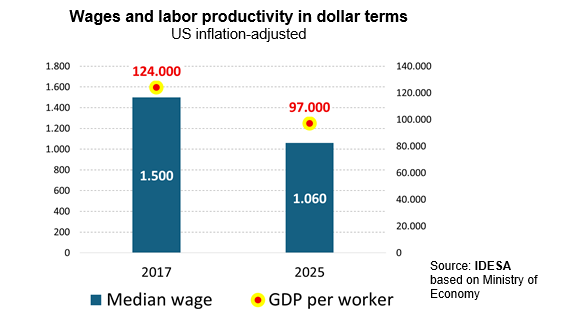Report Nº: 112829/06/2025
The decline in productivity explains the paradox that labor costs are high for employers, while people perceive that they earn low wages. This cannot be solved by devaluation, but rather by structural reforms that create a more favorable environment to increase productivity.

With inflation falling, although still persistent, prices in Argentina are high when measured in dollars. This has led to a paradox. On the one hand, people complain that wages are low and insufficient to make ends meet. On the other hand, the production sectors complain that wages are high in dollars, putting exporters and industries that compete with imports in dire straits.
Inducing a devaluation of the peso could lower wages in dollar terms, making exports and industries that compete with imports more competitive. But it will worsen the situation of the people due to wage erosion. Conversely, yielding to unions’ pressure by allowing wages to rise could improve the purchasing power of wages, but at the cost of exacerbating competitiveness problems.
Faced with this dilemma, it is useful to compare the current situation with some point in the past. In this regard, according to data from the Ministry of Economy, it is observed that:
These data show that compared to 2017 —the year before the currency crisis unleashed, the aftermath of which is still present— both wages and productivity fell significantly. Therefore, the paradox of low wages for people but high wages for producers can be explained by the fact that each employee produces less. It follows that Argentina’s main challenge today is to improve economic efficiency to increase the added value generated by each worker.
Another very suggestive reference is that in the mid-1990s, wages measured in dollar terms were also around $1,000 at current prices. A similar level to today. But productivity (GDP per registered private employee) was 60% higher. This warns that, beyond the legitimacy of demands for better pay, under current conditions, the government should remain extremely conservative in validating wage increases decided in centralized collective bargaining between sectoral unions and business associations. It is highly recommended that wage updates be defined at the level of each company so that they are consistent with their productivity do not forcing job losses.
To improve wages and competitiveness simultaneously, it is essential to create a more favorable environment for production. The agenda is very broad. However, three elements are essential and urgent: a) improving productive infrastructure at all three levels of government; b) improving taxes by establishing that the super VAT absorbs provincial and municipal sales taxes; and c) improving labor regulations by allowing SMEs to opt out of old collective agreements signed centrally by sectoral unions and employer associations of dubious representativeness.
In general, there is a tendency among economists to exaggerate the importance of exchange rate policy and to make superficial and generic references to productivity policies. Reversing these biases will help all three levels of government take a less passive stance toward reforms that are vital for simultaneously increasing wages and the competitiveness of domestic production.